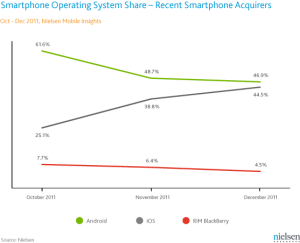Based on the mobile-related work we’ve been doing at Redpoint throughout 2010 and 2011, we’ve believe we have enough data points to predict where many enterprises will be focusing from a mobile perspective in 2012.
As of this writing, it is clear that two mobile platforms have the majority of marketshare and momentum in the US: Android and iOS.
Although it looked as though Android would far surpass iOS in the summer of 2011, recent market data from Nielsen (Jan 2012) shows that iOS sales (due to the release of the iPhone 4S) had a significant spike in Q42011. Regardless of the actual marketshare, it is clear from our work that the far majority of mobile development will continue to target iOS and Android devices.
During 2010 and the first half of 2011 we built many applications that were public facing and helped our clients achieve a mobile app presence. This wave of app development is very analogous to the way enterprises approached their web presence in the late 90s. These mobile apps typically expose a portion of our client’s website features in a mobile app. Many of the first generation enterprise apps only publish information and did not allow for any data modification in the mobile app. However, even in an information consumption-only mode, smartphones can provide incredible value. For example, location aware smartphones allow integration of location-based services to implement high-value features such as geo-fencing. Many of these first generation market presence apps are consumer facing and therefore user experience (UX), usability and overall experience were and continue to be tremendously important.
The second half of 2011 and the beginning of 2012 are clearly focusing less on getting a mobile presence and more around 1) setting an overall enterprise mobile strategy 2) focusing on enabling the internal enterprise workforce and partners with mobile apps and 3) being agile & using mobile as a competitive business advantage. We’re seeing a healthy mix of features and apps that publishing information (information consumption) and an increasing number of true transactional features and apps where data is synchronized bidirectionally to/from the enterprise and mobile app.
Although the aesthetics has traditionally taken a backseat to other IT functions, we see user experience (UX) continuing to climb in importance in enterprise IT projects because platforms such as iOS have changed user expectations around consistency, aesthetics and usability.
What are you seeing in the enterprise marketplace? Let us know…
